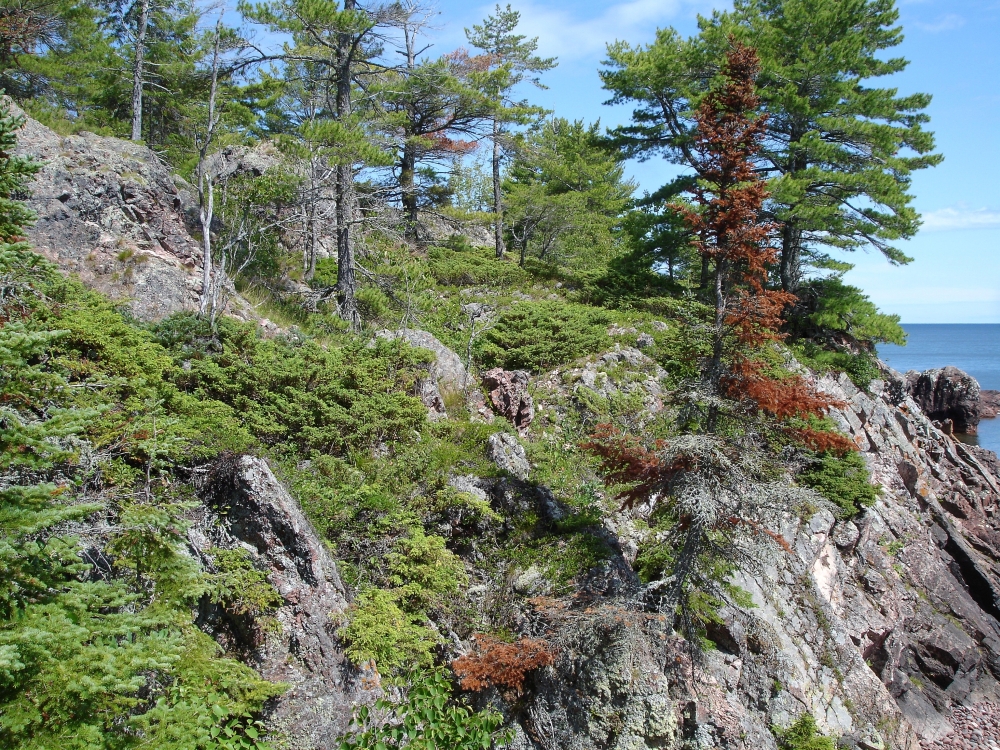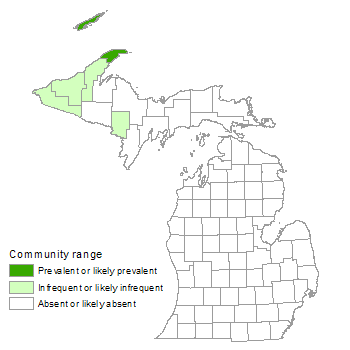Volcanic Bedrock Glade
Overview
Volcanic bedrock glade consists of an open forested or savanna community found where basaltic bedrock and conglomerates are exposed. The sparse vegetation consists of scattered open-grown trees, scattered shrubs or shrub thickets, and a partial turf of herbs, grasses, sedges, mosses, and lichens. The community occurs in the western Upper Peninsula on Isle Royale and the Keweenaw Peninsula, extending southwest into Houghton, Ontonagon, and Gogebic Counties.
Rank
Global Rank: GU - Unrankable
State Rank: S2 - Imperiled

Landscape Context
Basalt and conglomerate bedrock are typically tilted about 40 degrees from horizontal, creating a landscape where vegetation cover is often sparse and unstable. Volcanic bedrock glades typically occupy areas of steep to stair-stepped slopes, with short cliffs and exposed bedrock knobs. The community occurs both inland and adjacent to the Lake Superior shoreline. The forest types surrounding volcanic bedrock are typically dry-mesic northern forest or mesic northern forest, but along the Lake Superior shoreline, boreal forest is a common associate, as are volcanic bedrock lakeshore, volcanic cobble shore, volcanic lakeshore cliff, and sand and gravel beach.
Soils
Continental glacial ice sheets from about 10,000 years ago left large areas of bedrock devoid of soil. Some organic soil has developed in pockets and cracks within the volcanic rock, but there are also large areas with no soil, where lichens and mosses are the predominant vegetation. The prevalent rock formations are Precambrian-age Copper Harbor Conglomerates and Portage Lake Volcanics. The volcanic rock formed from vast sheets of flowing lava, interbedded with thin layers of conglomerate, which consisted of both pebbles and cobbles. Basalt, the predominant bedrock of the glades, ranges from medium acid to mildly alkaline in pH. Arctic-alpine vegetation is more common on the conglomerate and on volcanic rock characterized by many vesicles (vesicular basalt), which have more irregularities and cracks for soil development and root anchoring, than on massive basalt, which typically lacks vesicles.
Natural Processes
Windthrow, desiccation, and fire are all important natural processes influencing volcanic bedrock glade communities. Rock erosion results in accumulation of loose rocks (talus) at the base of slopes. Windthrown trees are common as a result of thin soils and strong winds associated with Lake Superior. Thin soils, cold winter temperatures, steady winds, and summer droughts make vegetation especially prone to desiccation. Rain that lands on sloping bedrock outcrops quickly runs off to lower elevation areas, further contributing to dry conditions and removing accumulated plant debris that could otherwise initiate soil formation. Glades are subject to fires from both lightning and human sources. Both white pine (Pinus strobus) and red pine (P. resinosa) form a supercanopy and are prime targets for lightning strikes associated with Lake Superior storms. The open structure and elevated position above Lake Superior of glades make them ideal places for historic and modern human gathering, which were and are associated with escaped campfires.
Vegetation
Vegetation cover ranges from nearly absent on exposed outcrops of basalt or conglomerate to dense where soil has accumulated on talus or in joints and depressions. The scattered overstory is dominated by white pine, red pine, jack pine (Pinus banksiana), paper birch (Betula papyrifera), quaking aspen (Populus tremuloides), white spruce (Picea glauca), balsam fir (Abies balsamea), and red oak (Quercus rubra). Common shrubs include bearberry (Arctostaphylos uva-ursi), creeping juniper (Juniperus horizontalis), common juniper (J. communis), trailing arbutus (Epigaea repens), wild rose (Rosa acicularis), soapberry (Shepherdia canadensis), low sweet blueberry (Vaccinium angustifolium), Canada blueberry (V. myrtilloides), Canada bilberry (V. membranaceum), thimbleberry (Rubus parviflorus), and serviceberry (Amelanchier spp.). Common grasses are poverty grass (Danthonia spicata), hair grasses (Avenella flexuosa and Deschampsia cespitosa), and rough-leaved rice grass (Oryzopsis asperifolia). Common forbs include cow-wheat (Melampyrum lineare), twinflower (Linnaea borealis), harebell (Campanula rotundifolia), wild strawberry (Fragaria virginiana), yarrow (Achillea millefolium), bastard toadflax (Comandra umbellata), red honeysuckle (Lonicera dioica), large-leaved aster (Eurybia macrophylla), and Canada mayflower (Maianthemum canadense). Bracken fern (Pteridium aquilinum) can also be common. Lichens (e.g., Cladina spp. and Usnea spp.) and mosses (e.g., Polytrichum spp.) are typically abundant to locally dominant.
For information about plant species, visit the Michigan Flora website.
Plant Lists
Graminoids
- wavy hair grass (Avenella flexuosa)
- poverty grass (Danthonia spicata)
- tufted hair grass (Deschampsia cespitosa)
- rough-leaved rice grass (Oryzopsis asperifolia)
Forbs
- yarrow (Achillea millefolium)
- small pussytoes (Antennaria howellii)
- wild columbine (Aquilegia canadensis)
- low bindweed (Calystegia spithamea)
- harebell (Campanula rotundifolia)
- pink corydalis (Capnoides sempervirens)
- small blue-eyed Mary (Collinsia parviflora)
- bastard-toadflax (Comandra umbellata)
- prairie cinquefoil (Drymocallis arguta)
- large-leaved aster (Eurybia macrophylla)
- wild strawberry (Fragaria virginiana)
- geocaulon (Geocaulon lividum)
- twinflower (Linnaea borealis)
- Canada mayflower (Maianthemum canadense)
- cow-wheat (Melampyrum lineare)
- early saxifrage (Micranthes virginiensis)
- rough-leaved rice grass (Oryzopsis asperifolia)
- balsam ragwort (Packera paupercula)
- bracken fern (Pteridium aquilinum)
- old-field goldenrod (Solidago nemoralis)
Ferns
- male fern (Dryopteris filix-mas)
- bracken fern (Pteridium aquilinum)
Lichens
- reindeer lichens (Cladina spp.)
- usnea lichens (Usnea spp.)
Mosses
- haircap mosses (Polytrichum spp.)
Woody Vines
- red honeysuckle (Lonicera dioica)
- poison-ivy (Toxicodendron radicans)
- riverbank grape (Vitis riparia)
Shrubs
- serviceberries (Amelanchier spp.)
- bearberry (Arctostaphylos uva-ursi)
- pipsissewa (Chimaphila umbellata)
- bush honeysuckle (Diervilla lonicera)
- trailing arbutus (Epigaea repens)
- wintergreen (Gaultheria procumbens)
- common juniper (Juniperus communis)
- creeping juniper (Juniperus horizontalis)
- wild rose (Rosa acicularis)
- thimbleberry (Rubus parviflorus)
- soapberry (Shepherdia canadensis)
- low sweet blueberry (Vaccinium angustifolium)
- tall bilberry (Vaccinium membranaceum)
- Canada blueberry (Vaccinium myrtilloides)
Trees
- balsam fir (Abies balsamea)
- juneberry (Amelanchier arborea)
- paper birch (Betula papyrifera)
- white spruce (Picea glauca)
- jack pine (Pinus banksiana)
- red pine (Pinus resinosa)
- white pine (Pinus strobus)
- quaking aspen (Populus tremuloides)
- red oak (Quercus rubra)
- mountain-ash (Sorbus decora)
- northern white-cedar (Thuja occidentalis)
Noteworthy Animals
Ants are quite abundant in this dry, thin-soiled environment. Black bears use the habitat, possibly because of the abundance of ants, other insects, and wild fruit.
Rare Plants
- Arnica cordiformis (heart-leaved arnica, state endangered)
- Castilleja septentrionalis (pale Indian paintbrush, state threatened)
- Crataegus douglasii (Douglas’s hawthorn, state special concern)
- Phacelia franklinii (Franklin’s phacelia, state threatened)
Rare Animals
- Falco peregrinus (peregrine falcon, state endangered)
- Lycaeides idas nabokovi (northern blue butterfly, state threatened)
Biodiversity Management Considerations
The thin soils and lichen cover are easily destroyed by off-road vehicles or excessive foot traffic. Many seasonal cabins are built within the glades, resulting in major degradation, including the introduction of non-native plants. Fill is often introduced for septic systems, also increasing habitat for invasive plants. Invasive plants that threaten the diversity and community structure in volcanic bedrock glades include spotted knapweed (Centaurea stoebe), ox-eye daisy (Leucanthemum vulgare), Canada bluegrass (Poa compressa), Kentucky bluegrass (P. pratensis), sheep sorrel (Rumex acetosella), and hawkweeds (Hieracium spp.).
Monitoring and control efforts to detect and remove these and other invasive species will help maintain the native biodiversity of volcanic bedrock glade and surrounding natural communities. Given that the thin soils and slow-growing lichen and moss cover are sensitive to anthropogenic disturbance and recover slowly, conservation efforts should focus on preserving the ecological integrity of existing high-quality volcanic bedrock glades. Open conditions within glades can be maintained by allowing wildfires to move through the community where safety and other conditions permit. Prescribed fire management of adjacent dry-mesic forests should include areas of bedrock glade when feasible.
Variation
Recent studies indicate that volcanic bedrock glades on Isle Royale are often dominated by white spruce and balsam fir, although quaking aspen may dominate more recently burned sites.
Similar Natural Communities
Northern bald, granite bedrock glade, limestone bedrock glade, dry-mesic northern forest, boreal forest, volcanic bedrock lakeshore, and granite bedrock lakeshore. Northern bald is a similar plant community occurring on the extreme exposed bedrock at the highest elevations on the Keweenaw Peninsula and stretching southwest into Gogebic County.
Places to Visit
- Bare Bluffs Glade, Michigan Nature Association (Grinnell Memorial Sanctuary at Bare Bluff), Keweenaw Co.
- Fish Cove, Baraga State Forest Management Unit, Keweenaw Co.
- Isle Royale National Park, Keweenaw Co.
- Horseshoe Harbor, The Nature Conservancy (Mary Macdonald Preserve at Horseshoe Harbor), Keweenaw Co.
- Porcupine Mountain Glades, Porcupine Mountains Wilderness State Park, Ontonagon Co.
- Traps Hills Escarpment, Ottawa National Forest, Ontonagon Co.
Relevant Literature
- Albert, D.A., P. Comer, D. Cuthrell, D. Hyde, W. MacKinnon, M. Penskar, and M. Rabe. 1997. The Great Lakes bedrock lakeshores of Michigan. Michigan Natural Features Inventory, Lansing, MI. 218 pp.
- Bornhorst, T.J., and W.I. Rose. 1994. Self-guided geological field trip to the Keweenaw Peninsula, Michigan. Proceedings of the Institute on Lake Superior Geology. Volume 40, Part 2. 185 pp.
- Dorr, J.A., Jr., and D.F. Eschman. 1970. Geology of Michigan. University of Michigan Press, Ann Arbor, MI. 470 pp.
- Faber-Langendoen, D., ed. 2001. Plant communities of the Midwest: Classification in an ecological context. Association for Biodiversity Information, Arlington, VA. 61 pp. + appendix (705 pp.).
- Given, D.R., and J.H. Soper. 1981. The arctic-alpine element of the vascular flora at Lake Superior. National Museums of Canada, Publication in Botany 10: 1-70.
- LaBerge, G.L. 1994. Geology of the Lake Superior region. Geoscience Press. Phoenix, AZ. 313 pp.
- Reed, R.C., and J. Daniels. 1987. Bedrock geology of northern Michigan. State of Michigan Department of Natural Resources. Map: 1: 500,000.
- Reschke, C. 1985. Vegetation of the conglomerate rock shoreline of the Keweenaw Peninsula, northern Michigan. M.S. thesis. University of Wisconsin, Madison, WI. 118 pp.
- Slavick, A.D., and R.A. Janke. 1987. The vascular flora of Isle Royale National Park. Michigan Botanist 26: 91-134.
For a full list of references used to create this description, please refer to the natural community abstract for Volcanic Bedrock Glade.
More Information
Citation
Cohen, J.G., M.A. Kost, B.S. Slaughter, D.A. Albert, J.M. Lincoln, A.P. Kortenhoven, C.M. Wilton, H.D. Enander, and K.M. Korroch. 2020. Michigan Natural Community Classification [web application]. Michigan Natural Features Inventory, Michigan State University Extension, Lansing, Michigan. Available https://mnfi.anr.msu.edu/communities/classification. (Accessed: January 16, 2025).
Kost, M.A., D.A. Albert, J.G. Cohen, B.S. Slaughter, R.K. Schillo, C.R. Weber, and K.A. Chapman. 2007. Natural Communities of Michigan: Classification and Description. Michigan Natural Features Inventory, Report No. 2007-21, Lansing, MI.


